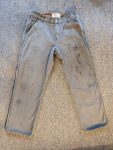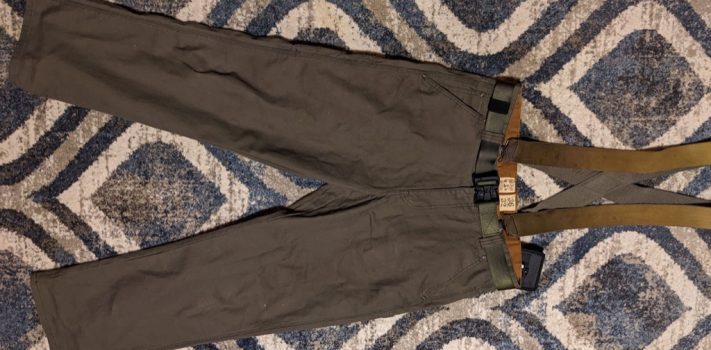RedHead Ultimate Work Pants have an appropriate name: they are a good pair of pants to wear while working. They are comfortable, durable, stain resistant, and well-cut. The pants, which are manufactured in Bangladesh, are made of a lightweight cotton canvas. They retailed for $39.99 at Bass Pro Shops at the time of this writing.
The Backstory
I recently decided that two of my pairs of work jeans had reached the end of their useful life. The holes had gotten large enough that I had a hard time getting my feet through the legs of the pants rather than through the holes.
That left me with space for a couple of more pairs of work pants on my closet shelf. I started looking for some good used jeans at the thrift stores that my wife and I frequent, and asked her to do the same.
About a week or so into our search, I got a call from my wife. She indicated that she had found me a pair of work pants at one of our local thrift stores. The pants were in like new condition, and my wife paid a grand total of $4.99 plus tax for the garment.
Description
The pants had a “RedHead” tag in the back of the waistband. An Internet search revealed that the RedHead brand is owned by Bass Pro Shops of Springfield, Missouri.
The date of manufacture was listed as June of 2019.
A search of the style number listed on a tag sewn into the waistband brought me to the RedHead Ultimate Work Pants on the Bass Pro Shops website.
The pants are 100% cotton. They are olive on the outside. The inside of the waistband is brown.
Other colors available on the Bass Pro website are listed as “Bungee Cord”, “Vintage Khaki” and “Gray”. I find it difficult to believe that the same marketing department came up with the color “Bungee Cord” was content to settle on the color “Gray”. Stranger things have happened, I guess.
There are rivets on the corners of the pockets, a couple of extra tool pockets on the sides of the legs, and a hammer loop on one of the legs. The current version pictured on the Bass Pro Shops website no longer appears to have the hammer loop.
More Like the Original Levi’s
The original Levi’s were made with brown cotton duck rather than denim. This makes the RedHead work pants more like the original Levi’s than the current Levi’s are.
It was the rivets on the pockets and the bottom of the fly that were the defining characteristic of the original Levi’s. This feature was patented in 1873. The original Levi’s had just one back pocket. The second back pocket was added in 1901.
Deer and Color
A hunter wearing a pair of olive-colored work pants is less conspicuous to a deer than one wearing a pair of blue-colored pants.
This is because deer are most sensitive to short wavelength colors like blue. Deer also lack the UV light filter that helps to protect human eyes from long-term damage from that portion of the electromagnetic spectrum. Since deer have a shorter life span than humans, their eyes do not need to be built for the long run. The practical outworking of this sensitivity to short wavelengths and lack of a UV filter is that deer see blue more vividly than any other color.
So my RedHead work pants would be a better garment for me to wear while deer hunting than a pair of blue jeans.
Impressions
I wore the RedHead work pants while performing a number of outdoor tasks. I wore them for tasks like preparing our outside wood boiler for the summer downtime, rototilling the garden, and splitting wood.

 As a result of these experiences, I decided that I like the pants very much. I found the cotton canvas to be more comfortable than denim during warmer temperatures. I also found it to be durable, and to shed dirt better than denim. I have a couple of pairs of similar Docker’s brand work pants. I feel that the RedHead pants are cut better than the Docker’s. The Docker’s work pants are a bit too baggy, and make me feel clown-like when I wear them in public. The RedHead pants, on the other hand, are cut in a way that I would not be ashamed to wear into town. Well, that is, before I got them stained, working on a project.
As a result of these experiences, I decided that I like the pants very much. I found the cotton canvas to be more comfortable than denim during warmer temperatures. I also found it to be durable, and to shed dirt better than denim. I have a couple of pairs of similar Docker’s brand work pants. I feel that the RedHead pants are cut better than the Docker’s. The Docker’s work pants are a bit too baggy, and make me feel clown-like when I wear them in public. The RedHead pants, on the other hand, are cut in a way that I would not be ashamed to wear into town. Well, that is, before I got them stained, working on a project.
Pants History
Pants seem to have originated in the nomadic equestrian cultures of Central Asia as a more appropriate garment than tunics for the riding of horses. From there they spread to the Scythians, Sarmatians, Sogians, Bactrians, and a host of other people groups.
The oldest surviving pair of pants was found on a mummy in Tacharia in Western China. They date back to about 1200-900 BC.
In Exodus 28:42, God mandated that the priests in the tabernacle should wear linen pants under their robes in order to protect their modesty.
The Greeks and Romans viewed pants as ludicrous and outlandish, a style favored by backward barbarians beyond the reach of civilization.
As Roman control extended into the more northerly regions of Europe, Roman soldiers discovered that pants could be more comfortable than tunics during cold and damp weather. Pants began to become more and more widely adopted as an item of Roman military attire. They proved so practical that they began to gain popularity among civilians as well.
Pants styles have subsequently appeared in an almost infinite variety in terms of length, tightness, fabric selection, color, pockets, pleats, fasteners, etc.
Pants are better than other garment choices for the lower extremities for maintaining modesty during vigorous activity and for protecting the skin from the elements, from dirt, and from abrasion.
Keeping Pants Up
When at the office, out shopping, or relaxing at home, I generally use just a belt to hold up my pants. But when performing manual labor, I generally wear both a belt and suspenders. When both of my hands are occupied while splitting wood, running a chainsaw, or pushing a wheelbarrow, it is good to have my pants secured in a way that assures that they won’t start to creep down.
I know that in fine society, many consider wearing both a belt and suspenders to be a fashion faux pas. This tells me that many fashionistas don’t have much experience with harvesting wood. The world’s largest Paul Bunyan statue in Akeley, Minnesota portrays the folk hero as wearing both a belt and suspenders. If it is good enough for Paul Bunyan, it is good enough for me.
Belts have been documented as an item of male clothing since the bronze age. Although they could help to secure items of clothing like tunics, one of their major functions was as a place to attach weapons and equipment. There are references to belts throughout ancient literature, including a reference to the belt of truth in an allusion to Roman military equipment in Ephesians 6:14.
During some periods of fashion history, pants were attached to an upper garment to help hold them up.
The first suspenders were strips of ribbon popularized in France beginning in the 1700s. Benjamin Franklin and Napoleon Bonaparte are said to have favored this method of holding up their britches.
In the early 1800s, pants became so high-waisted that it became impractical for them to be held up by a belt. Modern suspenders were introduced by Albert Thurston in 1822 as a solution to this problem. For the next 100 years or so, suspenders largely replaced belts as a method of holding up pants. Samuel Clemens, better known by his pen name Mark Twain, received a US patent for a type of suspenders in 1871.
The first suspenders had an H back pattern, though that pattern has largely been replaced by the X and Y back patterns.
Following World War I, the waistband of pants migrated downward again, and belts displaced suspenders in popularity.
The History of the RedHead Brand
The RedHead brand name was first used by the E.C. Cook and Bro. Company in 1908.
When the Cook company went bankrupt in 1915, some former employees formed the Alward, Anderson, Southard Company. They then acquired the Cook assets and product line.
In 1956, the bowling ball manufacturer Brunswick Blake Collender acquired the RedHead brand from Alward, et al.
The brand was sold again in 1970, and was eventually acquired by Bass Pro Shops, Inc. The brand is now sold primarily by Bass Pro Shops and their associated chain, Cabela’s.
Conclusions
RedHead Ultimate Work Pants are comfortable, durable, and reasonably attractive. In their olive-colored version, they would be less conspicuous in the field than blue jeans. I am glad that my wife found me a nice pair at a good price.
Disclaimer
I did not receive any financial or other inducements to mention any vendor, product, or service in this article.










